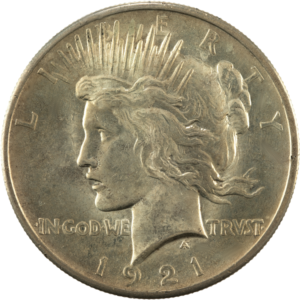
Coin Snapshot
- Weight: 26.96 grams
- Composition: 90% silver, 10% copper
- Diameter: 38.1mm
- Thickness: 2.4mm
- Years Minted: 1921-1928, 1934-1935
- Designed by: Anthony de Francisci
- Total Coins Struck: 190,577,279 (1921-1935)*
*Beginning in 2021, a modern bullion version of the Peace Dollar was released by the US Mint to commemorate the 100th year anniversary of the Peace Dollar being released. Due to its immense success, it has been minted each year since 2021. The specs above reflect the original coins (minted from 1921 to 1928, 1934 and 1935).
The Peace Silver Dollar is one of America’s most iconic and historical coins. First minted in 1921, it was introduced to commemorate world peace following World War I. It also served to fill the need for a silver dollar after the Morgan Dollar stopped being produced in 1904. It holds a special place among numismatists and collectors due to its symbolic design and historical significance. Struck in 90% silver, each coin weighs approximately 26.96 grams and holds a face value of $1 USD.
The Peace Silver Dollar was produced in significant quantities between 1921 and 1928 and again in 1934 and 1935, making it one of the most recognized silver dollars today. The highest number of coins were struck between 1922 and 1925, making those dates the most commonly available today. The Peace Dollar continues to captivate both investors and collectors due to its beauty, precious metal content, and historical background.
If you are looking to add historical U.S. coins to your collection, the Peace Silver Dollar is an excellent choice. The coin features stunning artwork and a strong connection to a pivotal moment in history, making it a prized piece for those who appreciate numismatic artistry and historical significance. Since it was produced in such large quantities during its time in circulation, there are still plenty of Peace Dollars available on the market today. Whether you are looking for a circulated Peace Dollar due to its silver content, or a specific date – Peace Dollars can be found abundantly online and also at local coin shops.
Peace Dollar Coin Design
The Peace Silver Dollar was designed by Italian sculptor, Anthony de Francisci after he was selected in a competition for having the best design. In May 1921, Charles Moore, chairman of the U.S. Commission of Fine Arts, and Buffalo nickel designer James Earle Fraser met with Mint Director Baker to discuss a competition for the design of a new silver dollar. This was formalized in July, with a prize of $1,500 set aside for the winning sculptor and $100 for other participants. President Harding issued an executive order requiring that coin designs be submitted to the Commission for approval.
By November, it was determined that congressional approval wasn’t needed to replace the Morgan Dollar, as it had been struck for over 25 years, making it eligible for replacement. The Peace Dollar design competition began, inviting renowned sculptors like Hermon MacNeil, Victor D. Brenner, and Adolph Weinman. The artists were tasked with creating a Liberty head for the obverse and an eagle for the reverse, along with standard inscriptions.
On December 13, 1921, the Commission reviewed the designs and unanimously selected Anthony de Francisci’s design, which would become the Peace Silver Dollar.
Obverse Design
The obverse of the Peace Silver Dollar was designed by renowned sculptor Anthony de Francisci. It features a striking image of Lady Liberty wearing a radiant crown, reminiscent of the Statue of Liberty. De Francisci’s design was influenced by his wife, Teresa, who served as the model for Lady Liberty. The inscription “LIBERTY” runs across the top of the coin, while the motto “IN GOD WE TRUST” is located at the bottom, with “TRUST” spelled using a distinctive “V” in place of a “U” to signify the Roman influence. The year of issue is displayed prominently at the bottom, emphasizing the coin’s importance as a commemoration of peace.
Lady Liberty’s portrait on the Peace Dollar exudes a serene yet determined expression, symbolizing the nation’s hope for lasting peace. The obverse design marked a departure from the earlier Morgan Dollar, focusing more on the ideals of tranquility rather than industrial growth.
Reverse Design
The reverse of the Peace Dollar is just as powerful in symbolism as the obverse. It features a majestic bald eagle perched atop a mountain, clutching an olive branch in its talons. The eagle, a national symbol of strength and freedom, is looking towards the rising sun, a representation of a new era of peace. The word “PEACE” is inscribed beneath the eagle, emphasizing the coin’s central theme.
Around the edge of the reverse side, the inscriptions “UNITED STATES OF AMERICA” and “E PLURIBUS UNUM” encircle the eagle. The denomination “ONE DOLLAR” is displayed prominently below the eagle, making it clear that this coin was a standard unit of American currency. The artistry of the reverse design aligns perfectly with the coin’s message of hope for a peaceful future following the devastation of the Great War.
Mint Locations and Mintmarks on the Peace Dollar
Peace Silver Dollars were minted in three primary locations: Philadelphia, Denver, and San Francisco. The mintmark, indicating the location where the coin was produced, is found on the reverse, just below the word “ONE” in “ONE DOLLAR.” Each mint contributed to the production of these coins in varying quantities, which impacts their availability and rarity today.
Coins struck at the Philadelphia Mint bear no mintmark, which is standard for coins produced there. Those minted in Denver feature a small “D” mintmark, and coins minted in San Francisco are marked with an “S.” Due to the differences in production numbers between the mints, coins from certain locations are rarer and can command higher prices, especially in higher grades of preservation.
If you’re interested in learning more about specific mintmarks on other U.S. coins, be sure to explore our detailed guides on the subject.
History of the Peace Dollar
The Peace Silver Dollar was born out of a desire to create a coin that symbolized the end of World War I and the return to global peace. The U.S. Mint had ceased producing silver dollars after 1904 due to an overabundance of Morgan Dollars, but the passage of the Pittman Act in 1918 required the melting down of over 270 million silver dollars. This created the need for new silver coinage.
In 1921, the U.S. Mint held a competition to select a new design for the nation’s silver dollar, with the stipulation that it must represent peace. Anthony de Francisci’s design was chosen, and the first Peace Dollars were minted in high relief that same year. However, the high-relief design caused production issues, and subsequent years saw the coins produced in lower relief.
The Peace Dollar was minted from 1921 to 1928 and again in 1934 and 1935. After 1935, production ceased, and it wasn’t until 2021 that the U.S. Mint issued a special commemorative Peace Dollar to mark its 100th anniversary. This coin continues to be a favorite among collectors due to its symbolic nature and its connection to a pivotal moment in U.S. history.
For those interested in delving deeper into the history of U.S. coin production, we offer a variety of articles that explore the fascinating evolution of American currency.
Peace Silver Dollar Prices
The value of a Peace Silver Dollar can vary greatly depending on factors such as its year of issue, mintmark, condition, and rarity. Common dates, especially in circulated condition, can be purchased for relatively affordable prices, often closely tied to the current price of silver. However, rare dates and coins in pristine condition can command significantly higher prices.
Silver prices play a significant role in determining the baseline value of these coins, but their numismatic value often exceeds their silver content. For collectors, grading and certification can greatly impact a Peace Dollar’s value, as higher-grade examples are far rarer and more desirable.
Examples of Rare and Expensive Peace Dollars
Several Peace Dollars are considered rare and can be particularly valuable. The 1921 Peace Dollar, due to its high-relief design and lower mintage, is one of the most sought-after by collectors. Another highly valuable coin is the 1928 Peace Dollar, which had a significantly smaller production run compared to other years. Coins minted in San Francisco with an “S” mintmark, such as the 1934-S Peace Dollar, are also highly sought after due to their relative rarity.
Among the rarest of Peace Dollars is the 1964-D Peace Dollar. Although these coins were struck at the Denver Mint, none were officially released, and the few that may exist are considered illegal to own. This story adds a layer of intrigue to the Peace Dollar series, making it a fascinating pursuit for collectors.
Peace Dollar Condition and Certification
The condition of a Peace Dollar can greatly affect its value. Coins are generally graded on the Sheldon Scale, which ranges from 1 to 70, with higher numbers representing coins in better condition. Uncirculated or “mint state” (MS) Peace Dollars are particularly desirable, as they have not suffered the wear and tear that comes with circulation.
Certification by a third-party grading service, such as PCGS or NGC, provides assurance to buyers and sellers regarding the authenticity and condition of a coin. Certified Peace Dollars in high grades, especially those with rare mintmarks or from specific years, can be quite valuable. Collectors often seek certified examples to ensure they are purchasing a coin of the advertised quality.
For more information on the grading of U.S. silver dollars, check out our detailed guide on how coin grading works and what to look for when buying certified coins.
Buying Peace Silver Dollars Online
If you are interested in adding Peace Silver Dollars to your collection, purchasing online can be a convenient and efficient option. Many reputable dealers offer certified and graded Peace Dollars, which ensures the authenticity and quality of the coins. However, it’s crucial to buy from trusted sources to avoid counterfeits or misrepresented items.
When buying online, consider factors such as shipping costs, return policies, and customer reviews. Look for dealers who provide detailed photographs and descriptions of the coins they offer. Some dealers specialize in rare U.S. coins and offer a wide selection of Peace Dollars at various price points.
Online auctions and marketplaces are another popular way to acquire Peace Silver Dollars. While these platforms can offer competitive prices, buyers should exercise caution and ensure they are dealing with reputable sellers. Coins should ideally be certified by PCGS or NGC to guarantee their authenticity.
Whether you’re a seasoned collector or a beginner, owning a Peace Silver Dollar is a tangible connection to history and an excellent investment in both silver and U.S. coinage. Explore our collection of silver dollars for sale and find the perfect addition to your portfolio.
